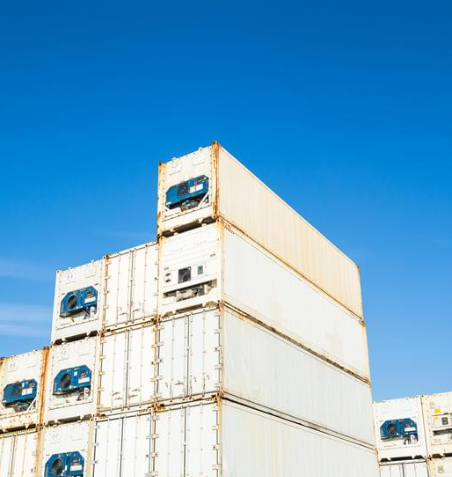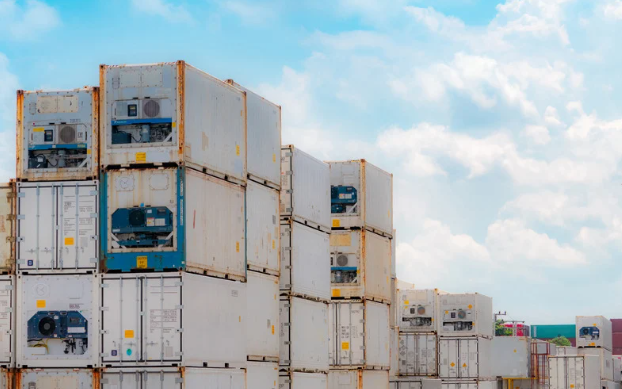The Future of Reefer Intermodal Shipping: Top Innovations in 2025
In the fast-evolving world of logistics, 2025 marks a pivotal year for Reefer Intermodal shipping. As global commerce continues to rise and consumer expectations for fresh, temperature-controlled products increase, companies across Canada and beyond are turning to Reefer Intermodal solutions for efficiency, sustainability, and innovation. Whether you’re shipping produce, pharmaceuticals, or frozen goods, the advancements in reefer technology and multimodal logistics are reshaping the way sensitive cargo moves through the supply chain.
Reefer Intermodal combines the best of refrigerated shipping containers and multimodal transport. This means your temperature-sensitive cargo can be transported seamlessly by truck, train, or ship – without compromising cold chain integrity. The innovations emerging in 2025 are game-changers for any business that relies on temperature control, especially as regulations tighten and consumer expectations increase for traceability and quality.
Why now? Three major forces are converging to accelerate innovation in Reefer Intermodal logistics: the global demand for cold chain infrastructure, the expansion of smart container technology, and a strong push toward eco-friendly supply chains. Canada’s role is particularly important here. With major intermodal hubs like Vancouver, Montreal, and Toronto, Canadian companies have a unique opportunity to lead in modern reefer logistics, bridging the gap between producers, markets, and international ports.
One of the most exciting developments is the integration of real-time telematics in reefer containers. With cutting-edge IoT sensors, shippers can now monitor temperature, humidity, location, shock impact, and even door activity in real time. This visibility allows companies to act swiftly if cargo conditions fall outside of the desired range – preventing spoilage, minimizing liability, and increasing customer satisfaction.
In 2025, sustainability is no longer a buzzword – it’s a business imperative. New electric-powered reefer units and energy-efficient cooling systems are reducing the carbon footprint of intermodal transport. Innovations like solar panels on container roofs and the use of AI for optimized route planning are helping companies lower emissions and improve margins. Many intermodal rail providers are now prioritizing green reefer solutions as part of their long-term climate goals.
Automation is also having a moment. From self-checking sensors to predictive maintenance software, modern reefer containers are designed to minimize downtime and human error. Predictive AI platforms are now capable of analyzing past shipments, external weather data, and real-time carrier performance to make smarter logistics decisions. For businesses dealing with high-value perishable goods, this means more reliability and fewer costly disruptions.
Canada’s intermodal infrastructure has evolved to support these innovations. National rail networks like CN and CP are increasingly investing in upgraded reefer yards and temperature-regulated transfer stations. Ports such as Vancouver and Halifax are rolling out AI-assisted container management systems that expedite reefer transitions between ships, trucks, and trains – ensuring minimal handling and faster delivery times.
For food, pharmaceutical, floral, or biotech industries, Reefer Intermodal is becoming the gold standard. The days of relying solely on long-haul refrigerated trucking are fading. Instead, a hybrid approach – combining truck for first/last-mile delivery and rail for long-distance transport – reduces congestion, fuel costs, and delays.
Finally, regulation is playing a driving role. In Canada, both Health Canada and the CFIA (Canadian Food Inspection Agency) have been tightening standards for cold chain management. Meeting these new requirements is easier and more cost-effective when using Reefer Intermodal systems that offer end-to-end traceability, temperature logs, and digital audit trails.
Whether you’re a seasoned logistics manager or new to temperature-sensitive shipping, now is the time to modernize your operations. The companies that embrace Reefer Intermodal innovations in 2025 will benefit from greater control, lower risk, enhanced sustainability, and a competitive edge in the market.

What is a Reefer?
A “reefer” is short for “refrigerated container” – specialized intermodal container designed to transport temperature-sensitive goods. These containers are equipped with built-in refrigeration units that maintain a consistent internal temperature, ensuring cargo like produce, meat, dairy, pharmaceuticals, and chemicals arrive in perfect condition. Reefers are an essential part of the cold chain logistics ecosystem, maintaining integrity from origin to destination.
Reefers come in standard sizes – typically 20- or 40-foot lengths – and are compatible with trucks, trains, and ships, making them ideal for intermodal shipping. Inside, the reefer unit can cool, freeze, or even heat the cargo space depending on what the shipment requires. Many containers also include insulation, airflow systems, and humidity control to meet strict environmental conditions for delicate goods.
What truly sets modern reefers apart is their connectivity. Many of today’s reefer containers include IoT sensors and GPS trackers, offering real-time visibility into temperature, door status, shock events, and location. This level of insight enables better decision-making, compliance with international regulations, and increased peace of mind for both shippers and customers.
How Does Reefer Intermodal Work?
Reefer containers operate on a closed-loop system, actively managing temperature to ensure the safe transport of perishable goods. This system continuously collects heat from the container’s interior, pumps it outwards, and dissipates it. This intricate process allows the reefer to maintain a constant, desired temperature for extended periods. Imagine transporting ice cream – the reefer unit will tirelessly work to maintain a frigid -40°F environment until the ice cream reaches its destination. This technology, known as cold chain logistics, forms the backbone of safe and reliable transportation for temperature-sensitive products.
Reefer units achieve cooling primarily through two methods:
- Cryogenic Cooling
This method utilizes the natural cooling effect of carbon dioxide as it transitions from a solid to a gas state. Essentially, frozen carbon dioxide “ice” melts within the system, absorbing heat from the container’s interior.
- Diesel-Powered Generators
These generators provide the power needed to operate the reefer unit’s cooling system, ensuring chilled conditions for the cargo throughout its journey.
Reefer Components
Unlike your standard trailer, a reefer is a high-tech cooler on wheels, packed with extra parts to keep things nice and cold inside. Here’s a breakdown of what makes a reefer work:
- The Mighty Reefer Unit
This is the heart of the whole operation. It’s like a mini air conditioner that keeps the inside cool.
- Air Chute
Imagine a giant funnel! This helps direct cool air throughout the container.
- Insulated Box
This acts like the thick walls of your cooler, keeping the cold air in and the hot air out.
- Heavy Duty Tires
Just like any big rig, reefers need strong tires to handle the weight and different road conditions.
- Smooth Ride Suspension
This fancy system helps keep the ride smooth, protecting the cargo and the reefer unit itself.
- Dedicated fuel Tank
Reefers have their own dedicated fuel tank, separate from the truck’s fuel. This special tank can hold up to 50 gallons, and the best part? How the truck is driven doesn’t affect how much fuel the reefer uses.
Now, let’s get into the science behind keeping things cold! Reefers use a closed system with these key players:
- The Compressor
This acts like a tiny pump, sucking in warm air and squeezing it tight, turning it into hot liquid.
- The Condenser
This is like a radiator. It takes the hot liquid from the compressor and cools it down using outside air, releasing the heat.
- The Evaporator
This is the real chiller! It takes the cooled liquid and turns it back into gas. In this process, it absorbs heat from the air inside the container, making it nice and cold. The cool air then blows throughout the trailer, and the cycle starts all over again!
By working together, these parts ensure your favorite frozen treats, fresh fruits, and other temperature-sensitive goodies arrive perfectly chilled at their destination.
Why Use Reefer Intermodal?
Unlike other standard shipping containers, reefer containers ensure a wide variety of temperature-sensitive goods arrive at their destination fresh, delicious, and ready to use.
Here’s a glimpse of what you might find traveling inside a reefer:
- Perishable delights
This includes all your favorites – fresh fruits and vegetables, dairy products, and delicious meats.
- Beverages you love
From refreshing sodas to your morning coffee, some beverages also require a cool journey.
- Life-saving medications
Certain pharmaceuticals need precise temperature control to maintain their effectiveness.
- Baked goods on the move
Frozen pastries and other treats often travel in reefers to stay fresh for longer.
Using reefer containers is crucial for several reasons:
- Protecting from Freeze
Some products are sensitive to freezing temperatures and need a cool, but not freezing, environment.
- Maintaining Stability
For items that require consistent temperature control, reefers ensure they stay perfectly chilled throughout their journey.
- Keeping You Informed
Modern reefers are equipped with state-of-the-art technology:
- Control Units
These allow for remote monitoring and adjustment of the temperature inside the trailer.
- Temperature Sensors
These provide real-time data on the temperature conditions within the container.
- GPS Tracking
You can track your shipment’s location and ensure it arrives on time and at the optimal temperature.
By utilizing reefers and their advanced features, businesses can guarantee their temperature-sensitive goods reach their destination in pristine condition, preventing spoilage and safeguarding valuable revenue.

Types of Reefer Intermodal Containers
When it comes to single-temperature reefer intermodal trailers, a variety of options cater to specific needs. Here’s a breakdown of some popular models:
- Precedent S-750i: This diesel-electric unit is ideal for retailers, fleets, and pharmaceutical transport. Its focus on efficiency makes it a budget-friendly choice.
- Precedent S-600: An eco-friendly option, this CARB-certified unit eliminates the need for a DPF filter and boasts impressive fuel savings.
- Precedent S-700: Need to maintain deep freeze temperatures? This powerful unit is perfect for frozen goods. It’s also CARB-certified and customizable to your business requirements.
- Precedent C-600: This cost-effective single-temperature unit is backed by a reliable dealer network for easy maintenance and support.
- SLXi Local Trailer: Designed for urban deliveries, this lightweight reefer offers quieter operation, making it ideal for city environments.
Remember, the best reefer unit for your needs depends on your specific cargo, budget, and operational requirements. Consult with a reefer expert to determine the perfect fit for your business.
Drivers Guide for Handling Intermodal Reefer’s
There are two key parts of operating Reefer Intermodal freights, they are –
Picking Up Intermodal Reefer
When a driver is tasked with a “live intermodal reefer pickup”. That is mainly collecting a reefer container from the rail yard. Some of the steps crucial for this smooth operation are:
- Fuel Up
The driver should ensure the reefer unit’s fuel tank is filled, guaranteeing uninterrupted operation during transport.
- Temperature Verification
The container’s temperature setting must be meticulously checked and adjusted to precisely match the specific needs of the cargo.
- Alarm System Check
Prior to departure, a thorough inspection of the reefer’s alarm system is vital to identify any potential issues before they escalate.
Delivery of Intermodal Reefer
For deliveries involving a loaded reefer intermodal container originating from the rail yard, the driver’s focus shifts to ensuring the cargo reaches its destination in optimal condition.
- Fuel Gauge Monitoring
Due to the uncertainty of remaining fuel in the generator (genset), the driver must meticulously check the fuel gauge upon receiving the container.
- Fueling for Delivery
If the fuel level is insufficient, it’s imperative to refuel the genset before proceeding. This ensures the temperature remains consistent throughout the delivery process.
- Fuel Reimbursement
Carriers can claim reimbursement for fuel costs by including them as an “accessorial charge” associated with the trip.
Conclusion
As we wrap up our exploration of the cutting-edge advancements in Reefer Intermodal shipping, it’s clear that 2025 is ushering in a new era of reliability, intelligence, and sustainability for temperature-sensitive logistics. The innovations outlined above – from IoT-enhanced containers to AI-driven route optimization – are transforming reefer intermodal from a niche solution into a cornerstone of modern supply chains. If your business depends on the quality and timely delivery of perishable or high-value goods, now is the time to invest in these forward-looking technologies.
What makes Reefer Intermodal so powerful is its ability to combine the flexibility of trucking with the long-haul efficiency of rail and maritime transport. The integration of these modes allows for more control, fewer disruptions, and greater cost-efficiency – especially in a country as vast and trade-dependent as Canada. Whether you’re shipping blueberries from British Columbia, vaccines from Toronto, or seafood from the Maritimes, intermodal systems provide the stability needed to maintain your cold chain across great distances and changing conditions.
One of the most valuable takeaways in 2025 is that Reefer Intermodal isn’t just for large corporations anymore. Mid-sized and even small businesses now have access to container sharing, flexible leasing, and third-party logistics providers offering turnkey reefer solutions. With digital freight platforms becoming more accessible and user-friendly, booking a refrigerated container for intermodal transit is nearly as easy as scheduling a parcel courier. This democratization of technology is creating exciting new opportunities across food, pharma, and ecommerce sectors.
Additionally, data transparency and predictive analytics are redefining how companies make logistics decisions. Instead of reacting to spoilage or delays, today’s shippers can proactively prevent issues before they arise. By leveraging cloud-based platforms that aggregate route data, performance histories, weather conditions, and equipment diagnostics, businesses can fine-tune their operations and build more resilient cold chain strategies.
Reefer Intermodal also plays a crucial role in addressing modern regulatory pressures. With increased scrutiny on food and pharmaceutical supply chains, compliance is no longer optional—it’s a competitive necessity. The ability to provide complete temperature records, geo-stamped milestones, and documented chain-of-custody reports is now essential for audits, customs clearance, and brand trust. Modern reefer containers equipped with smart tracking systems make this level of documentation easy and automated.
Sustainability is another area where Reefer Intermodal offers distinct advantages. Rail transport emits significantly less CO₂ per ton-mile compared to long-haul trucking, and new electric-powered reefers are reducing diesel dependence across all modes. Companies that incorporate intermodal strategies into their sustainability roadmaps are seeing gains not only in emissions reduction but also in brand reputation and cost savings. Carbon-conscious consumers and B2B clients are increasingly choosing partners who can prove their environmental commitment – and intermodal shipping is a smart way to get there.
Looking ahead, the Canadian logistics landscape is set to expand even further. Infrastructure investments at major ports and inland terminals are creating more temperature-controlled capacity, shorter transfer times, and smarter container handling. This includes cold storage expansions, electrified reefer plugs at railyards, and automated yard management systems that move containers quickly and efficiently between modes. For businesses shipping cross-country or internationally, these developments mean shorter transit windows and lower risk of cargo degradation.
Let’s not forget the importance of customer experience. In an era where delays and damaged goods can go viral in minutes, businesses must deliver consistently high-quality service to protect their reputation. With Reefer Intermodal, you gain a more predictable and monitored shipping environment, one that reassures clients and minimizes service failures. Providing your customers with updates backed by real-time data creates transparency and fosters long-term trust.
In 2025, embracing Reefer Intermodal is more than a smart logistics move – it’s a strategic decision that impacts your bottom line, your sustainability goals, and your ability to scale. As technology continues to evolve and cold chain requirements become more complex, businesses that adopt agile, multimodal solutions will stand out in competitive industries and weather global challenges with greater resilience.
Whether you’re considering your first intermodal reefer shipment or looking to upgrade your current operations, RailGateway is here to help you take the next step with confidence. Our team is dedicated to helping Canadian businesses tap into the most advanced and cost-effective reefer logistics available today – so you can move your goods smarter, faster, and safer.

FAQ’s
1. What is reefer intermodal shipping, and how does it work?
Reefer intermodal shipping refers to the transportation of temperature-sensitive cargo using refrigerated containers (reefers) that travel across multiple modes of transport – typically rail, truck, and sea. The seamless transfer of containers between these modes allows goods to stay in a single refrigerated unit throughout the journey, ensuring consistent temperature control from origin to destination. Reefer intermodal shipping combines the flexibility of trucking with the cost-efficiency and sustainability of rail and maritime freight.
2. Why is reefer intermodal important for shipping in Canada?
Canada’s vast geography and climate variability make reefer intermodal shipping a critical solution for maintaining the cold chain across long distances. Whether you’re moving perishable goods from coast to coast or across the U.S. border, reefer intermodal provides reliable temperature control and reduces transit time interruptions. It also enables businesses to take advantage of Canadian rail infrastructure while minimizing road congestion and fuel consumption.
3. What industries benefit most from reefer intermodal shipping?
Industries that rely on consistent temperature control benefit most from reefer intermodal, including food and beverage, pharmaceuticals, biotechnology, cosmetics, and fine art. For example, fresh produce, frozen seafood, vaccines, and lab reagents are commonly shipped via intermodal reefers due to their sensitivity to temperature fluctuations. The ability to track and manage these conditions across transport modes makes reefer intermodal a top choice for critical and high-value cargo.
4. How do I ensure temperature integrity in reefer intermodal shipments?
Maintaining temperature integrity in reefer intermodal shipments is achieved through pre-cooling containers, monitoring internal conditions, and using GPS-enabled IoT sensors. Many providers now offer real-time alerts and cloud dashboards that show temperature, humidity, and shock levels. Choosing trusted partners and using smart reefer containers ensures that cargo remains within its required temperature range throughout multimodal transit.
5. Is reefer intermodal more expensive than traditional trucking?
While reefer intermodal may have slightly higher upfront costs due to specialized equipment, it often delivers cost savings over long distances when compared to refrigerated trucking alone. Rail shipping reduces fuel costs, driver fees, and emissions, which can offset the price of reefer container usage. Many businesses find that the improved reliability, scalability, and lower claims rates make reefer intermodal a smart long-term investment.
6. How can I track my cargo in a reefer intermodal shipment?
Today’s reefer intermodal shipments can be tracked in real time through integrated logistics platforms. GPS trackers and onboard telematics devices provide updates on container location, temperature, and handling conditions. Shippers receive alerts for any anomalies, helping to prevent spoilage or damage. Many providers also offer downloadable reports for compliance and performance analysis.
7. What are the sustainability benefits of reefer intermodal shipping?
Reefer intermodal shipping significantly lowers carbon emissions by shifting a large portion of long-haul freight to rail or ship, which use less fuel per ton-mile than trucks. Additionally, modern reefers are increasingly powered by electric or hybrid systems, reducing diesel consumption and noise pollution. Businesses using reefer intermodal can improve their environmental impact and align with green shipping initiatives.
8. Can small businesses use reefer intermodal services?
Absolutely. The reefer intermodal landscape in 2025 is more accessible than ever, thanks to container-sharing options, third-party logistics (3PL) services, and on-demand digital booking platforms. Small and mid-sized businesses can now access affordable reefer solutions without having to commit to full container loads, making it easier to ship temperature-controlled goods regionally or nationally.
9. What documentation is needed for reefer intermodal shipments?
When shipping with reefer intermodal, typical documentation includes a bill of lading, temperature logs, customs paperwork (for cross-border moves), and chain-of-custody reports. Many logistics providers streamline this process with digital platforms that auto-generate compliance records and allow real-time document sharing. Proper documentation ensures smoother border clearance and regulatory compliance, especially for food and pharma products.
10. How do I choose the right reefer intermodal provider?
Choosing the right reefer intermodal provider means looking for partners with proven experience in temperature-controlled logistics, a solid intermodal network, real-time tracking capabilities, and strong customer support. Ask about their reefer container specs, data reporting tools, and incident response protocols. A reliable provider should be transparent, tech-enabled, and committed to protecting your cargo at every stage of the journey.
Additional Resources
1. UNCTAD – Refrigerated Transport and Food Security
Why it’s great:
This authoritative United Nations page explains the importance of refrigerated transport in reducing food loss, supporting sustainable logistics, and achieving global supply chain reliability.
2. U.S. Department of Agriculture – Guide to Cold Chain Logistics
Why it’s great:
This USDA resource includes reports and insights on cold chain logistics, including refrigerated container use, best practices, and intermodal considerations in agricultural transport.
3. International Institute of Refrigeration – Logistics and Cold Chain Research
Why it’s great:
Offers in-depth studies and global innovation updates on refrigerated intermodal containers, energy efficiency, and cold chain sustainability across transport modes.
4. World Economic Forum – The Future of Cold Chain Logistics
Why it’s great:
Focuses on future innovations in the cold chain, including digital transformation and green tech in refrigerated intermodal shipping, helping reduce global food waste.
How We Can Help
For businesses looking to optimize their freight shipping with reliable, efficient, and cost-effective solutions, RailGateway.ca is your trusted partner in intermodal logistics. Whether you’re new to freight trains or want to enhance your existing supply chain, our team of intermodal experts is ready to guide you every step of the way.
Contact RailGateway.ca today for a free quote or to speak directly with one of our experienced intermodal specialists. Let us help you unlock smarter, smoother shipping solutions tailored to your unique needs.
Visit RailGateway.ca or call us to get started on transforming your freight shipping strategy in 2025 and beyond.





